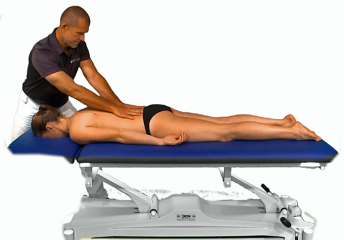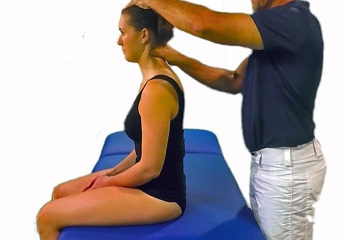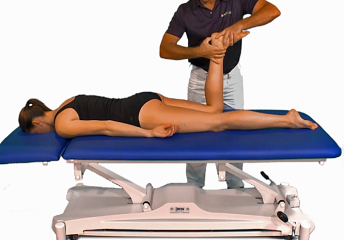Thorakolumbální fascie (THORACOLUMBAR FASCIA)
THORAKOLUMBÁLNÍ FASCIE
Poloha pacienta: Leží na břiše, hlava opřená o čelo.
Postavení terapeuta: Stojí vedle lehátka směrem k hlavě nebo nohám pacienta podle zamýšleného směru posunu. Při terapii je lepší stát na ošetřované straně.
Provedení: Při vyšetření terapeut položí obě ruce na záda symetricky vlevo i vpravo, paralelně s páteří (prsty směřují kraniálně nebo kaudálně). Na vyšetřované straně mírně zatlačí proti hrudníku a pak provede posun do předpětí a následně zapruží. Vyšetření se provádí na každé straně zvlášť. Oblasti vyšetření jak směrem kraniálním, tak kaudálním jsou od lopatek po lumbosakrální přechod. Při terapii položí jednu ruku na ošetřované místo a druhou pod ní (tou se jen opírá o pacienta pro zlepšení své stability, nejedná se o fixaci!). Rukou, která provádí terapii, zatlačí mírně směrem ventrálně a provede posun do předpětí. Dále čeká na fenomén tání. Po dokončení terapie v základním směru, může změnit směr posunu diagonálně.
Stejnou techniku lze provádět na dalších oblastech hrudníku a pánve.
Laterální fascie hrudníku: Pacient leží na břiše, aktivní ruka terapeuta je položena na laterální straně hrudníku směrem kraniálním nebo kaudálním, druhá je položena na zádech pro zlepšení stability.
Ventrální fascie hrudníku: Pacient leží na zádech, terapeut vyšetřuje posun fascie na přední straně hrudníku v různých lokalitách včetně oblasti sterna (mimo oblast prsou). Směr posunu je kraniálně i kaudálně, popřípadě i diagonálně.
Gluteální fascie: Pacient leží na břiše, terapeut položí ruce na hýždě a vyšetřuje nebo ošetřuje posun směrem kraniálním i kaudálním.
Terapie: Technika čekání v předpětí.
Poznámky: Technika uvolňuje „přilepení“ aponeurotické fascie s vlastní epimysiální fascií svalu, která je pod ní uložená. To je dáno zvýšením viskozity kyseliny hyaluronové, která umožňuje hladké klouzání těchto fasciálních vrstev.
THORACOLUMBAR FASCIA
Patientposition: He (she) is lying on their stomach, his head resting on his forehead.
Position of the therapist: He (she) stands next to the couch towards the patient's head or feet, depending on the intended direction of movement. During therapy, it is better to stand on the treated side.
Execution:During the examination, the therapist places both hands on the back symmetrically to the left and right, parallel to the spine (fingers point cranially or caudally). On the examined side, he presses slightly against the chest and then shifts to pretension and then springs. The examination is carried out on each side separately. Areas of examination in both cranial and caudal directions are from the shoulder blades to the lumbosacral junction. During the therapy, he puts one hand on the treated area and the other under it (he just leans on the patient to improve his stability, it's not fixation!). With the therapy hand, push slightly ventrally and move into pretension. Next, he waits for the release phenomen. After completing the therapy in the basic direction, it can change the direction of displacement diagonally.
The same technique can be performed on other areas of the chest and pelvis.
Lateral fascia of the chest: The patient lies on the stomach, the active hand of the therapist is placed on the lateral side of the chest in a cranial or caudal direction, the other is placed on the back to improve stability.
Ventral fascia of the chest: The patient lies on his back, the therapist examines the shift of the fascia on the front of the chest in various locations, including the sternum (outside the breast area). The direction of displacement is cranially and caudally, possibly also diagonally.
Gluteal Fascia: The patient lies on his stomach, the therapist places his hands on the buttocks and examines or treats the shift in the cranial and caudal direction.
Therapy: Waiting barrier technique.
Comment:The technique loosens the "sticking" of the aponeurotic fascia with the muscle's own epimysial fascia, whichlies beneath it. This is due to an increase in the viscosity of hyaluronic acid, which allows these fascial layers to slides moothly.
SOUVISEJÍCÍ

Protažení ve vlně – Achillova šlacha ( STRETCHING IN THE WAVE – ACHILLES TENDON)

Protažení ve vlně – měkké tkáně pod Achillovou šlachou (STRETCHING IN THE WAVE – SOFT TISSUE UNDER THE ACHILLES TENDON)

Thorakolumbální fascie (THORACOLUMBAR FASCIA)

Klavipektorální fascie (CLAVIPECTORAL FASCIA)

Povrchová fascie cervikální (SURFACE CERVICAL FASCIA)



















